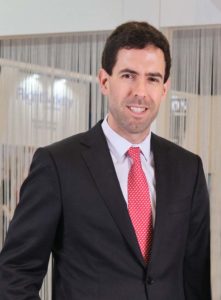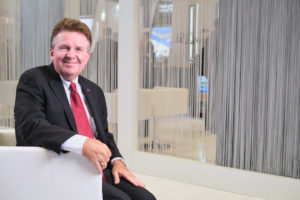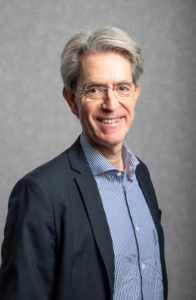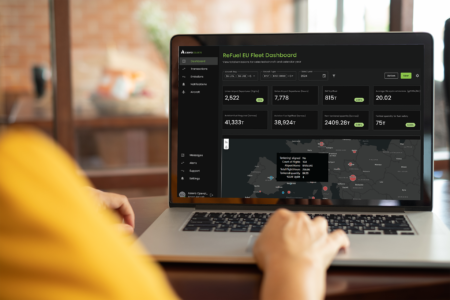Words by Ben Sampson
Leading suppliers discuss how to fuel the business aviation sector sustainably while growing SAF usage.
Kennedy Ricci, president, 4Air

How is 4Air helping to address the issue of aviation’s emissions?
We support the overall industry’s mission to achieve net zero by 2050, through a combination of verified carbon credits, Sustainable Aviation Fuel (SAF), operational improvements, and new technology. Each has a role to play.
Our goal is to make sustainability turnkey, so we help operators find how they can best engage with each of these pillars, and how they can marry voluntary sustainability goals to help meet their regulatory requirements.
What are the barriers to phasing out fossil fuels?
One of the challenges is the tracing and documentation for SAF. To determine how sustainable a SAF is and to claim the fuel for certain regulatory incentives, certain blending, fuel, and source information is needed.
We launched Assure in May, a blockchain-based web registry, which can document, trace, and account for these SAF attributes. By addressing a SAF tracking need for fuel suppliers, FBOs, airlines, and operators the registry also unlocks the opportunity for a robust book and claim tracking system.
What progress has 4Air made so far in helping aviation reduce greenhouse gas emissions?
In two years we have helped over 100 clients offset or reduce more than 2.5 million metric tons of CO2 using carbon offset credits and SAF. This is more than 550,000 flight hours or 275 million miles (442.57 million km) traveled.
4AIR has also provided clients with accounting and documentation for the physical and book and claim use of over 5.8 million gallons (21.95 million liters) of SAF.
How do you view the role of carbon offsetting?
Carbon offsets have a critical role to play in the decarbonization journey for aviation, but they are not the end solution. Few solutions can unlock truly zero emissions by 2050. SAF will take us a long way, assuming we see the successful ramp-up of production, but even at 100% blends, few SAFs are 100% carbon neutral.
Hydrogen and electric power may get us close but are also unlikely to contribute significantly to our emission reductions until after 2050 and there will still be residual emissions. Therefore, to compensate for the residual emissions or what we have not been able to abate by 2050, the use of verified carbon offsets and carbon removals will be important.
What are the key benefits and limitations of emissions trading schemes?
Emissions Trading Schemes are good at leveling the playing field. It will be interesting to see which approach incentives vs forced regulation – the USA vs EU – leads to the most success. Our key is to look at how we can leverage existing and coming regulations to help provide efficiencies for operators and align voluntary sustainability goals and compliance mechanisms with regulatory compliance to save operators costs.
How can companies balance environmental sustainability with competitiveness?
We see sustainability as a competitive advantage, but it is going to become part of our license to operate as
an industry.
Customers and prospects are increasingly requiring environmental disclosures. Airports are similarly requesting information on sustainability programs for new projects.
Pressure is coming from insurers, financiers, employees, and other stakeholders, so sustainability will increasingly become a vital part of a company’s ability to meet the needs of its stakeholders.
Stephen J. Leonard, vice president of Global Supply, AEG

How does AEG Fuels contribute to the development and promotion of SAF and reduce carbon emissions?
Our contribution to promoting our industry’s carbon emission reduction goals is through our efforts to continue pushing customers toward incorporating AEG’s sustainability program. Our program is designed to work with global aviation partners to set, analyze, and achieve in-house sustainability and emission reduction goals that align with the industry’s stated commitments.
We provide a ramp-up plan for our customers that incorporates four basic stepping stones: First, participate in a voluntary carbon offset credit procurement scheme; Second, invest and assign the emission reduction qualities resulting from SAF; Third, handle the transition to CORSIA (Carbon Offsetting and Reduction Scheme for International Aviation) and Emission Trading System compliant carbon offsets, and finally facilitate the physical procurement of SAF with the corresponding third-party attestations.
Our initiative is designed to help guide customers towards smoothly absorbing the increased operating expense of sustainability, while still meeting the expectations of their customers and industry peers. We do our best to be subject matter experts and make it as easy as possible for customers to reduce their emissions profile.
Can you elaborate on AEG Fuels’ work on developing the supply chain for SAF?
Our main role is to bridge the supply and demand gap between SAF producers and operators. We look to finance offtake agreements and then bring to market sustainable solutions that can be participated in on-demand, rather than via a long-term commitment.
Our purpose in the transaction is also to serve as a trusted counterparty for customers and ensure that any resulting sustainability or emission reduction claims are attestable to third parties. Purchasing SAF is productive but it’s perhaps even more critical that AEG supports customers in properly reporting emission reductions from the purchase.
How are you helping to scale up the production and adoption of SAF?
We have a global portfolio of existing SAF producers and producers with plans to produce SAF rather than just a regional network. We can offer SAF on a global basis to customers and allow them to customize their procurement plan to their actual flying habits.
This in turn supports scaling up production, because it democratizes access to the product and puts ready buyers in front of ready sellers faster than the current long-term agreement model.
How are you working with the industry on SAF and sustainability?
We are participating with the Council on Sustainable Aviation Fuel’s (CoSAFA) in its efforts to create a standardized set of standards for Book and Claim programs and maintain an International Sustainability and Carbon Certification (ISCC) trader license. Such collaborations ensure that our industry implements a fair, responsive and equitable framework for standardizing operators’ emission reduction claims.
What are your plans to improve the sustainability of aviation?
We plan to continue increasing the number of airports where AEG is either introducing SAF as a replacement molecule or supporting placing existing supply with ready demand. Customers can also use our existing technology suite – the SAF Fuel Management Platform and AEG Mobile – to start incorporating more emissions data and SAF information soon.
Andreea Moyes, global head of sustainability, Air bp
What are Air bp’s initiatives in sustainability and new fuels?
In 2020 bp set out its ambition to be a net zero company by 2050 or sooner and to help the world get to net zero. SAF has a key role to play in these aims and looking ahead, we see huge potential for it. We aim to supply 20% of global SAF demand by 2030 and to be the sustainability partner of choice for our industry.
We have deep experience in aviation fuel distribution, the technology needed for SAF, and scaling up the production and supply of this fuel. We are also leading with long term collaborations with customers, OEMs and other stakeholders.
How does Air bp see aviation’s transition from fossil fuels?
Even by 2050 kerosene is likely still to be the main source of energy for aviation, since hydrogen is unlikely to be able to address long-haul wide-body aircraft propulsion in this time frame, and the turnover of aircraft in the fleet takes time. So SAF is critical to meeting the industry’s goals. It has been estimated by IATA that SAF could contribute around 65% emissions reduction needed to help the industry reach its ambition of net zero in 2050, demonstrating the significant role it will play.
What R&D are you doing?
bp plays an ongoing role in R&D for SAF production technology – we co-developed and co-own with Johnson Matthey a process that uses municipal solid waste and other renewable biomass to produce SAF for example.
We are also making great progress around the world with co-processing, where vegetable oils, waste oils, and fats, or similar sustainable feedstocks are processed with crude oil feedstocks in existing refineries.
Using an existing refinery saves costs and reduces carbon because it removes the need to build dedicated processing units. The fuel can also enter the standard distribution infrastructure to airports.
Last year the bp plant in Lingen was the first production facility in Germany to use co-processing to produce SAF from waste and residues. Earlier this year, we announced the first sale of ISCC EU SAF produced through co-processing at bp’s Castellon refinery in Spain. We are also playing a role in securing approvals for new SAF pathways within ASTM.
How is Air bp helping reduce the cost of SAF?
In terms of production and infrastructure cost, one advantage of co-processing is that it uses existing facilities with just relatively minor modifications to produce SAF. These facilities then have greater flexibility in feedstocks and can switch between co-processing and processing of crude oil, to meet fluctuations in demand. There are currently around 600 refineries in the world, so that’s a huge production resource.
How is bp helping aviation adopt SAF?
We fueled the first SAF flight in February 2008 and since then we’ve been enabling test flights and investing in sustainable alternatives. To date, we’ve supplied SAF to over 30 locations to help drive the adoption of SAF.
Highlights include supplying the SAF for the A330’s first 100% SAF flight and our agreement with engine manufacturer Pratt & Whitney to explore a “viable supply” of 100% SAF for engine and propulsion systems testing through 2024.
Last year bp collaborated with DHL Express to contribute to the supply of 800 million liters of SAF. Other collaborations include NetJets Europe, the Centreline FBO at Bristol Airport, UK and a variety of helicopter customers such as CHC Helicopter Service, Bristow and ADAC.
C.R. Sincock II, executive vice president, Avfuel & Keith Sawyer manager of Alternative Fuels, Avfuel

How is Avfuel contributing to the adoption of SAF?
CRS: Avfuel takes a multi-pronged approach to support SAF’s integration into the supply chain. We provide consistent SAF supply through our partnership with Neste at 13 FBO locations and are adding more FBOs and airports rapidly to this list. We also supply a multitude of corporate flight departments and OEMs.
We work to scale SAF to global volumes able to meet its customers’ net-zero commitments by 2050 through partnerships with producers like Neste and Gevo. Awareness is also an important uptake driver. We routinely supply Neste MY Sustainable Aviation Fuel in limited quantities for special events at FBOs, airports, and major aircraft OEM bases. We participate in panels at industry events and work with the media and industry associations to educate customers and OEMs. Our alternative fuels team also works closely with customers to answer questions about the viability of SAF and confirm commitments for its use. We further consult with them as they integrate SAF into their sustainability metrics.
How is Avfuel supporting operators’ carbon emissions reduction goals?
KS: When SAF isn’t physically available, we also offer operators a book and claim option, where operators pay for SAF that is uplifted elsewhere, yet receive credit for its use. This process is highly regulated to ensure there is no double-counting.
We also offer a voluntary carbon offset program. Operators can purchase carbon credits with a small per-gallon fee on either a one-time or a rolling basis. The credits invest in certified green projects that reduce carbon emissions. A carbon credit offsets around 100 gallons of jet fuel.
What is your strategy for scaling up SAF production?
KS: By engaging in a high level of participation with producers, blenders and feedstock contributors, we remain well-informed on new SAF entrants and supply opportunities. It’s a true boots-on-the-ground approach – our team does everything it can to actively bring our customers, particularly our business aviation customers, greater access to SAF.
Is Avfuel involved in any other sustainability work?
KS: We continue to invest in sustainability-focused startups, like Air Company, which uses carbon-capture technology to make SAF, and VerdeGo Aero, which is developing a power solution for hybrid-electric aircraft. Working closely with these ambitious, innovative companies, I can tell you, the future of aviation is bright and clean.
What are the key challenges in promoting the use of SAF?
KS: Supply and demand continue to be the greatest logistical challenges. Having sustainability goals or being eco-conscious have been the main uptake drivers to date, but in the future legislative factors will drive SAF uptake, particularly in the USA. New technologies can also support SAF uptake. Beyond supply and demand, the logistics of blending the fuel continue to be a challenge for SAF.
How is Avfuel helping to make SAF cheaper?
KS: Avfuel works daily on all aspects of SAF supply and availability. Our alternative fuels team works with producers to make SAF more easily accessible to the end user. 
We work with FBOs, airports, OEMs, and corporate flight departments to secure offtake commitments and with trade organizations and industry groups to support legislative action.
Governmental policies and regulations for SAF will be incredibly important to support its widespread adoption. We expect the price differential to narrow as supply increases to meet demand over the next five years.
Joël Navaron, president of TotalEnergies Aviation
How does TotalEnergies view the future of aviation fuel in light of concerns about climate change?

Our ambition is to be a major player in the energy transition on the road to net zero by 2050. Our objective is to produce more energy and less emissions. This vision is backed by an investment policy designed to accelerate low-carbon solutions like renewable energies, biogas and biofuels, low-carbon fuels, and carbon capture and storage, while we continue to meet the world’s current energy demand.
TotalEnergies is prioritizing the production of SAF to decarbonize the aviation industry.
How are you helping to decarbonize the business aviation sector?
Biofuels emit at least 50% less CO2 than their fossil equivalents, making them a decarbonization pathway for liquid fuels and TotalEnergies has taken part in many biofuel initiatives since 2014. In 2021 we delivered SAF for the first time to airports in France and supplied the fuel for the country’s first SAF-powered flights.
Today, TotalEnergies distributes SAF permanently in 3 airports in France: Le Bourget, Bordeaux-Mérignac, and Clermont Ferrand.
We are focused on mature biofuel technologies that convert waste and residue into aviation biofuel, such as the use of HEFA (hydro-processed esters and fatty acids) SAF. This is the most economical SAF production technology. We are also pursuing coprocessing, where both biobased and fossil feedstock are used directly in the refining process to yield a SAF with a blend ratio of 1%. up to 5%.
Soon the use of CO2 as a feedstock will make it possible to decarbonize certain transportation sub-sectors even more broadly. Captured CO2 can be combined with green hydrogen to produce synthetic fuel or gas.
Last year in the UAE, we joined a project with Masdar and Siemens Energy to build a pilot renewable hydrogen plant that will be used to convert CO2 into SAF.
Can you share any targets for your production of SAF?
TotalEnergies aims to grow its production capacities to 1.5Mt of SAF produced by 2030.
We started coprocessing at our Normandie, France refinery in 2021 and are converting our Grandpuits refinery into a zero-crude complex. Grandpuits will include a biorefinery that will process more than 75% of waste and residue for a second life as biofuels and SAF in particular.
What other sustainability solutions is TotalEnergies currently exploring?
As a multi-energy company, we provide complementary solutions to SAF, such as electric refueling trucks and we are working on a carbon offsetting offer dedicated to the Business Aviation sector. We have also started to develop our electric charging offer around Paris at three different sites for general aviation purposes.
Do you think we need global standards for SAF?
One of the main levers that need to be put in place is a global regulatory framework for aviation to accelerate the development of SAF.
In Europe, the regulations are gradually developing. The RefuelEU regulation sets clear mandates for minimum SAF uplifts at EU airports – 2% by 2025, 6% by 2030, and up to 70% by 2050. It also defines the amounts of the minimum e-fuel share. We also welcome the RefuelEU requirement to put in place a Book &
Claim mechanism to manage the SAF supply in a flexible way across Europe.
We can therefore see that public policies are being put in place to support the industrial sector and to prepare today, together with aviation stakeholders, the landscape of tomorrow.
Matthew Whitton, vice president of Aviation and Land Supply Europe, World Fuel Services
How does World Fuel Services (WFS) view the role of SAF in business aviation?
The business aviation sector was a clear early adopter of blended SAF. We supported this by becoming the first producer of blended SAF in the UK during May 2019. Since then we have made the product available in business aviation hubs and marketed it to our customers appropriately. Paris–Le Bourget Airport was our first mainland European airport to have blended SAF, as part of an authorised distributor arrangement with Neste.
What measures is WFS implementing to reduce carbon emissions in aviation?
As blended SAF becomes more readily available WFS is putting in place an efficient supply chain to reduce GHG (Green House Gas) emissions across the supply chain. We can also provide sustainability information to our customers which demonstrates the GHG attributes that the product being supplied has. By doing this we inform our customers and enable them to make the best decision in respect of their sustainability ambition.
What are the challenges of using SAF compared to traditional jet fuel?
Product availability remains a challenge. The demand within Europe has continued to grow at a faster pace than SAF supply, partly because of mandates being introduced in Sweden and France.
WFS can commit volume to current producers and is actively participating in potential new production projects, in doing so WFS aims to provide a demand profile certainty to production plants. We are also involved in industry discussions to ensure that mandates are fit-for-purpose for the entire supply chain from day one.
What partnerships do you have to accelerate the development of SAF?
The working relationship with Neste from a current blended-SAF production perspective is well known and is well developed. We are also discussing actively with potential producers because as a company whilst the working relationship that we have with suppliers is truly important, we are ultimately supplier agnostic.
We aim to effectively fulfill our customer’s demand for blended SAF so that we can have a positive impact in enabling the supply chain to reduce its GHG emissions.
In business aviation we are present as suppliers at several locations with SAF and at Toulon Hyères Airport we deliver SAF to the wingtip by way of an all-electric into plane bowser.
How does WFS ensure the transparency and integrity of its SAF supply chain?
We purchase product from ISCC-accredited sources. ISCC accreditation is an industry-renowned and trusted mechanism that is fully audited to ensure both transparency and integrity of the supply chain. Once
the product has been sold to our customers, WFS can produce ISCC-approved documentation that provides the customer with the GHG-saving attributes of the product they have purchased.
Do you have any other plans to enhance sustainability in business aviation?
We aim to be at the forefront of fulfilling our customers’ sustainability demands within the sector. As a result, as different production pathways for blended-SAF are introduced and as additional products such as perhaps hydrogen and electric become available, we intend to be part of the solution that our customers need.
A superb example of further decarbonizing the aviation fuel supply chain was at Toulon–Hyères Airport in France. At this airport World Fuel Services is now capable of supplying blended-SAF at the wingtip using a fully electric Into plane truck.







